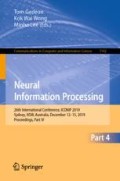Abstract
Two-dimensional partial least squares (2DPLS) is an effective two-view data analysis technique. However, conventional 2DPLS only takes into account the column information of two-dimensional images. In this paper, we simultaneously consider the column-wise and row-wise information of two-dimensional face images. We first propose a row-based two-dimensional PLS (r2DPLS) approach and then further present a novel double-directional PLS (D\(^{2}\)PLS) method. The proposed D\(^{2}\)PLS method can be optimized by two eigenvalue subproblems. Experimental results on the AR, Yale, and AT&T face databases show that our D\(^{2}\)PLS method can overall achieve better recognition accuracy than existing related methods.
Supported by Undergraduate Education and Teaching Reform Project of Yangzhou University under Grant YZUJX2016-32C; National Natural Science Foundation of China under Grants 61402203, 61703362, and 61611540347; Natural Science Foundation of Jiangsu Province of China under Grants BK20161338 and BK20170513; Yangzhou Science Project Fund of China under Grants YZ2016238 and YZ2017292; Excellent Young Backbone Teacher (Qing Lan) Project and Scientific Innovation Project Fund of Yangzhou University of China under Grant 2017CXJ033.
Access this chapter
Tax calculation will be finalised at checkout
Purchases are for personal use only
References
Wold, H.: Soft modelling by latent variables: the non-linear iterative partial least squares (NIPALS) approach. Perspect. Probab. Stat. 12(S1), 117–142 (1975)
Hotelling, H.: Relations between two sets of variates. Biometrika 28, 321–377 (1936)
Aleix, M.M., Avinash, C.K.: PCA versus LDA. IEEE Trans. Pattern Anal. Mach. Intell. 23(2), 228–233 (2001)
Hubert, M., Branden, K.V.: Robust methods for partial least squares regression. J. Chemometr. 17(10), 537–549 (2003)
Kondylis, A., Hadi, A.S.: Derived components regression using the bacon algorithm. Comput. Stat. Data Anal. 51(2), 556–569 (2006)
Chen, H., Sun, Y., Gao, J., Hu, Y., Yin, B.: Solving partial least squares regression via manifold optimization approaches. IEEE Trans. Neural Netw. Learn. Syst. 30(2), 588–600 (2019)
Xie, Q., Tang, L., Li, W., John, V., Hu, Y.: Principal model analysis based on partial least squares (2019). arXiv: 1902.02422
Liu, H., Ma, Z., Han, J., Chen, Z., Zheng, Z.: Regularized partial least squares for multi-label learning. Int. J. Mach. Learn. Cybern. 9(2), 335–346 (2018)
Talukdar, U., Hazarika, S.M., Gan, J.Q.: A kernel partial least square based feature selection method. Pattern Recogn. 83, 91–106 (2018)
Tao, J.-L., Zhang, J.-M., Wang, L.-J., Shen, X.-J., Zha, Z.-J.: Near-duplicate video retrieval through toeplitz kernel partial least squares. In: Kompatsiaris, I., Huet, B., Mezaris, V., Gurrin, C., Cheng, W.-H., Vrochidis, S. (eds.) MMM 2019. LNCS, vol. 11296, pp. 352–364. Springer, Cham (2019). https://doi.org/10.1007/978-3-030-05716-9_29
Qiao, J., Wang, G., Li, W., Li, X.: A deep belief network with PLSR for nonlinear system modeling. Neural Netw. 104, 68–79 (2018)
Liquet, B., de Micheaux, P.L., Hejblum, B.P., Thiébautt, R.: Group and sparse group partial least square approaches applied in genomics context. Bioinformatics 32(1), 35–42 (2016)
Sun, Q.S.: Research on feature extraction and image recognition based on correlation projection analysis. Ph.D. dissertation. Nanjing University of Science and Technology, Nanjing (2006)
Yang, M.-L., Sun, Q.-S., Xia, D.-S.: Two-dimensional partial least squares and its application in image recognition. In: Huang, D.-S., Wunsch, D.C., Levine, D.S., Jo, K.-H. (eds.) ICIC 2008. CCIS, vol. 15, pp. 208–215. Springer, Heidelberg (2008). https://doi.org/10.1007/978-3-540-85930-7_28
Zhang, Y.X., Huang, S., Feng, X., Zhang, J.H., Bu, W.B., Yang, D.: Two dimensional non-negative sparse partial least squares for face recognition. In: ICMEW, pp. 1–6, IEEE, Chengdu (2014)
Chu, M.T., Watterson, J.L.: On a multivariate eigenvalue problem: I. Algebraic theory and a power method. SIAM J. Sci. Comput. 14(5), 1089–1106 (1993)
Author information
Authors and Affiliations
Corresponding author
Editor information
Editors and Affiliations
Rights and permissions
Copyright information
© 2019 Springer Nature Switzerland AG
About this paper
Cite this paper
Yuan, YH. et al. (2019). D\(^{2}\)PLS: A Novel Bilinear Method for Facial Feature Fusion. In: Gedeon, T., Wong, K., Lee, M. (eds) Neural Information Processing. ICONIP 2019. Communications in Computer and Information Science, vol 1142. Springer, Cham. https://doi.org/10.1007/978-3-030-36808-1_44
Download citation
DOI: https://doi.org/10.1007/978-3-030-36808-1_44
Published:
Publisher Name: Springer, Cham
Print ISBN: 978-3-030-36807-4
Online ISBN: 978-3-030-36808-1
eBook Packages: Computer ScienceComputer Science (R0)

